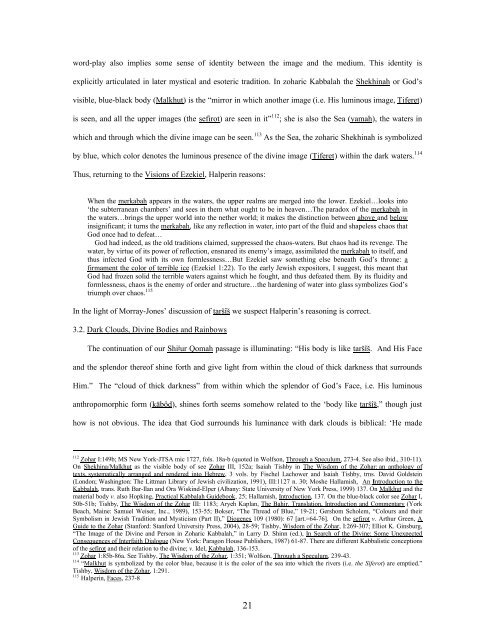Sapphiric God: - Dr. Wesley Muhammad
Sapphiric God: - Dr. Wesley Muhammad
Sapphiric God: - Dr. Wesley Muhammad
You also want an ePaper? Increase the reach of your titles
YUMPU automatically turns print PDFs into web optimized ePapers that Google loves.
word-play also implies some sense of identity between the image and the medium. This identity is<br />
explicitly articulated in later mystical and esoteric tradition. In zoharic Kabbalah the Shekhinah or <strong>God</strong>’s<br />
visible, blue-black body (Malkhut) is the “mirror in which another image (i.e. His luminous image, Tiferet)<br />
is seen, and all the upper images (the sefirot) are seen in it” 112 ; she is also the Sea (yamah), the waters in<br />
which and through which the divine image can be seen. 113 As the Sea, the zoharic Shekhinah is symbolized<br />
by blue, which color denotes the luminous presence of the divine image (Tiferet) within the dark waters. 114<br />
Thus, returning to the Visions of Ezekiel, Halperin reasons:<br />
When the merkabah appears in the waters, the upper realms are merged into the lower. Ezekiel…looks into<br />
‘the subterranean chambers’ and sees in them what ought to be in heaven…The paradox of the merkabah in<br />
the waters…brings the upper world into the nether world; it makes the distinction between above and below<br />
insignificant; it turns the merkabah, like any reflection in water, into part of the fluid and shapeless chaos that<br />
<strong>God</strong> once had to defeat…<br />
<strong>God</strong> had indeed, as the old traditions claimed, suppressed the chaos-waters. But chaos had its revenge. The<br />
water, by virtue of its power of reflection, ensnared its enemy’s image, assimilated the merkabah to itself, and<br />
thus infected <strong>God</strong> with its own formlessness…But Ezekiel saw something else beneath <strong>God</strong>’s throne: a<br />
firmament the color of terrible ice (Ezekiel 1:22). To the early Jewish expositors, I suggest, this meant that<br />
<strong>God</strong> had frozen solid the terrible waters against which he fought, and thus defeated them. By its fluidity and<br />
formlessness, chaos is the enemy of order and structure…the hardening of water into glass symbolizes <strong>God</strong>’s<br />
triumph over chaos. 115<br />
In the light of Morray-Jones’ discussion of taršîš we suspect Halperin’s reasoning is correct.<br />
3.2. Dark Clouds, Divine Bodies and Rainbows<br />
The continuation of our Shi#ur Qomah passage is illuminating: “His body is like taršîš. And His Face<br />
and the splendor thereof shine forth and give light from within the cloud of thick darkness that surrounds<br />
Him.” The “cloud of thick darkness” from within which the splendor of <strong>God</strong>’s Face, i.e. His luminous<br />
anthropomorphic form (kābôd), shines forth seems somehow related to the ‘body like taršîš,” though just<br />
how is not obvious. The idea that <strong>God</strong> surrounds his luminance with dark clouds is biblical: ‘He made<br />
112 Zohar I:149b; MS New York-JTSA mic 1727, fols. 18a-b (quoted in Wolfson, Through a Speculum, 273-4. See also ibid., 310-11).<br />
On Shekhina/Malkhut as the visible body of see Zohar III, 152a; Isaiah Tishby in The Wisdom of the Zohar: an anthology of<br />
texts, systematically arranged and rendered into Hebrew, 3 vols. by Fischel Lachower and Isaiah Tishby, trns. David Goldstein<br />
(London; Washington: The Littman Library of Jewish civilization, 1991), III:1127 n. 30; Moshe Hallamish, An Introduction to the<br />
Kabbalah, trans. Ruth Bar-Ilan and Ora Wiskind-Elper (Albany: State University of New York Press, 1999) 137. On Malkhut and the<br />
material body v. also Hopking, Practical Kabbalah Guidebook, 25; Hallamish, Introduction, 137. On the blue-black color see Zohar I,<br />
50b-51b; Tishby, The Wisdom of the Zohar III: 1183; Aryeh Kaplan, The Bahir. Translation, Introduction and Commentary (York<br />
Beach, Maine: Samuel Weiser, Inc., 1989), 153-55; Bokser, “The Thread of Blue,” 19-21; Gershom Scholem, “Colours and their<br />
Symbolism in Jewish Tradition and Mysticism (Part II),” Diogenes 109 (1980): 67 [art.=64-76]. On the sefirot v. Arthur Green, A<br />
Guide to the Zohar (Stanford: Stanford University Press, 2004), 28-59; Tishby, Wisdom of the Zohar, I:269-307; Elliot K. Ginsburg,<br />
“The Image of the Divine and Person in Zoharic Kabbalah,” in Larry D. Shinn (ed.), In Search of the Divine: Some Unexpected<br />
Consequences of Interfaith Dialogue (New York: Paragon House Publishers, 1987) 61-87. There are different Kabbalistic conceptions<br />
of the sefirot and their relation to the divine; v. Idel, Kabbalah, 136-153.<br />
113 Zohar 1:85b-86a. See Tishby, The Wisdom of the Zohar, 1:351; Wolfson, Through a Speculum, 239-43.<br />
114 “Malkhut is symbolized by the color blue, because it is the color of the sea into which the rivers (i.e. the Siferot) are emptied.”<br />
Tishby, Wisdom of the Zohar, 1:291.<br />
115 Halperin, Faces, 237-8<br />
21
















